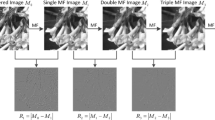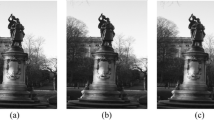Abstract
Median filtering, being an order statistic filtering, has been widely used in image denoising and recently also in image anti-forensics and anti-steganalysis. In the past few years, several methods have been developed for median filtering detection. However, it is still a challenging task to detect median filtering in JPEG compressed images. In this paper, we propose a novel method to solve this challenging task. We first generate median filtered residual (MFR), average filtered residual (AFR) and Gaussian filtered residual (GFR) by calculating the differences between an original image and its filtered images. Then, we propose to use two-dimensional autoregressive (2D-AR) model to characterize MFR, AFR and GFR separately, and further combine the 2D-AR coefficients of these three residuals into a set of features. Finally, the extracted feature set is fed into a support vector machine classifier for training and detection. Extensive experiments have demonstrated that compared with existing methods, the proposed one can achieve a considerable improvement in detecting median filtering in heavily compressed images.








Similar content being viewed by others
Notes
1 Streaking artifacts, first analyzed by Bovik [2], refer to the phenomenon that the probability of two adjacent pixels being the same increases greatly after median filtering, which can thus be evaluated by using first-order difference images.
References
Bas P, Filler T, Pevný T (2011) Break our steganographic system: the ins and outs of organizing BOSS Information hiding. Springer, Berlin, pp 59–70
Bovik AC (1987) Streaking in median filtered images. IEEE Trans Acoust Speech Signal Process 35(4):493–503
Chen J, Kang X, Liu Y, Wang ZJ (2015) Median filtering forensics based on convolutional neural networks. IEEE Signal Process Lett 22(11):1849–1853
Chen C, Ni J, Huang J (2013) Blind detection of median filtering in digital images: a difference domain based approach. IEEE Trans Image Process 22 (12):4699–4710
Cao G, Zhao Y, Ni R, Yu L, Tian H (2010) Forensic detection of median filtering in digital images Proceedings IEEE Int. Conf. Multimedia and Expo, pp 89–94
Dang-Nguyen D-T, Gebru ID, Conotter V, Boato G, De Natale FGB (2013) Counter-forensics of median filtering Proceedings IEEE Int. Workshop on Multimedia Signal Processing, pp 260–265
Dirik AE, Memon N (2009) Image tamper detection based on demosaicing artifacts Proceedings IEEE Int. Conf. Image Processing, pp 1497–1500
Dang-Nguyen D-T, Pasquini C, Conotter V, Boato G (2015) RAISE: a raw images dataset for digital image forensics Proceedings 6th ACM Multimedia Systems Conference, pp 219–224
Fan Z, de Queiroz RL (2003) Identification of bitmap compression history: JPEG detection and quantizer estimation. IEEE Trans Image Process 12(2):230–235
Fan W, Wang K, Cayre F, Xiong Z (2015) Median filtered image quality enhancement and anti-forensics via variational deconvolution. IEEE Trans Inf Forensics Secur 10(5):1076–1091
Farid H (2009) Image forgery detection. IEEE Signal Proc Mag 26:16–25
Fontani M, Barni M (2012) Image tamper detection based on demosaicing artifacts Proceedings 20th European Signal Processing Conference, pp 1239–1243
Fridrich J, Kodovsky J (2012) Rich models for steganalysis of digital images. IEEE Trans Inf Forensics Secur 7(3):868–882
Fu D, Shi YQ, Su W (2007) A generalized Benford’s law for JPEG coefficients and its applications in image forensics Proceedings SPIE, Electronic Imaging, Security and Watermarking of Multimedia Contents IX, vol 6505, pp 1L1–1L11
Furon T, Bas P (2008) Broken arrows. EURASIP J Inf Secur 2008, p 3
Gloe T, Böhme R The Dresden Image Database for benchmarking digital image forensics Proceedings 25th Symposium On Applied Computing (ACM SAC 2010), vol 2, pp 1585–1591
Gonzalez RC, Woods RE (2002) Digital image processing. Upper Saddle River NJ: Prentice-hall
Kang X, Li Y, Qu Z, Huang J (2012) Enhancing source camera identification performance with a camera reference phase sensor pattern noise. IEEE Trans Inf Forensics Secur 7(2):393–402
Kang X, Stamm MC, Peng A, Liu KJR (2013) Robust median filtering forensics using an autoregressive model. IEEE Trans Inf Forensics Secur 8(9):1456–1468
Kashyap RL (1984) Characterization and estimation of two-dimensional arma models. IEEE Trans Inf Theory 30(25):736–745
Kee E, Farid H (2011) A perceptual metric for photo retouching. Proc Natl Acad Sci 108(50):19907–19912
Kirchner M, Böhme R (2008) Hiding traces of resampling in digital images. IEEE Trans Inf Forensics Secur 3(4):582–592
Kirchner M, Fridrich J (2010) On detection of median filtering in digital images Proceedings SPIE, Electronic Imaging, Media Forensics and Security II, vol 7541, pp 1–12
Lai Y-N, Gao T-G, Li J-X, Sheng G-R (2015) Forensic detection of median filtering in digital images using the coefficient-pair histogram of DCT value and LBP pattern Proceedings Int Conf Intelligent, pp 421–432
Lin Z, He J, Tang X, Tang C-K (2009) Fast, automatic and fine-grained tampered JPEG image detection via DCT coefficient analysis. Pattern Recogn 42 (11):2492–2501
Lukas J, Fridrich J, Goljan M (2006) Digital camera identification from sensor pattern noise. IEEE Trans Inf Forensics Secur 1(2):205–214
(2002). Natural resources conservation service photo gallery, http://photogallery.nrcs.usda.gov/, United States Department of Agriculture
Pasquini C, Boato G, Alajlan N, De Natale FGB (2016) A deterministic approach to detect median filtering in 1D data. IEEE Trans Inf Forensics Secur 11 (7):1425–1437
Pevný T, Bas P, Fridrich J (2010) Steganalysis by subtractive pixel adjacency matrix. IEEE Trans Inf Forensics Secur 5(2):215–224
Piva A (2013) An overview on image forensics, ISRN Signal Processing, vol. 2013
Popescu AC, Farid H (2004) Exposing digital forgeries by detecting duplicated image regions, Dept Comput Sci, Dartmouth College, Tech Rep TR2004-515
Qiu X, Li H, Luo W, Huang J (2014) A universal image forensic strategy based on steganalytic model Proceedings 2nd ACM Workshop on Information hiding and multimedia security, pp 165–170
Rocha A, Scheirer W, Boult T, Goldenstein S (2011) Vision of the unseen: Current trends and challenges in digital image and video forensics. ACM Comput Surv 43(4):Article 26
Schaefer G, Stich M (2004) UCID: An Uncompressed color image database Proceedings SPIE 5307, Storage and Retrieval Methods and Applications for Multimedia, vol 5307, pp 472–480
Stamm MC, Liu KJR (2011) Anti-forensics of digital image compression. IEEE Trans Inf Forensics Secur 6(3):1050–1065
Wu Z-H, Stamm MC, Liu KJR (2013) Anti-forensics of median filtering Proceedings IEEE Int. Conf. acoustics, Speech, Signal Process, pp 3043–3047
Yuan H-D (2011) Blind forensics of median filtering in digital images. IEEE Trans Inf Forensics Secur 6(4):1335–1345
Yang J, Xie J, Zhu G, Kwong S, Shi YQ (2014) An effective method for detecting double JPEG compression with the same quantization matrix. IEEE Trans Inf Forensics Secur 9(11):1933–1942
Zhang Y, Li S, Wang S, Shi YQ (2014) Revealing the traces of median filtering using high-order local ternary patterns. IEEE Signal Process Lett 21(3):275–279
Zeng H, Qin T, Kang X, Liu L (2014) Countering anti-forensics of median filtering Proceedings IEEE Int Conf acoustics, Speech, Signal Process, pp 2704–2708
Acknowledgments
The authors appreciate the anonymous reviewers for their constructive comments. This work was supported in part by the National Natural Science Foundation of China under Grant 61572489 and Grant 61672554, and in part by the Youth Innovation Promotion Association of CAS under Grant 2015299.
Author information
Authors and Affiliations
Corresponding author
Additional information
Jianquan Yang and Honglei Ren contributed equally to this work
Rights and permissions
About this article
Cite this article
Yang, J., Ren, H., Zhu, G. et al. Detecting median filtering via two-dimensional AR models of multiple filtered residuals. Multimed Tools Appl 77, 7931–7953 (2018). https://doi.org/10.1007/s11042-017-4691-0
Received:
Revised:
Accepted:
Published:
Issue Date:
DOI: https://doi.org/10.1007/s11042-017-4691-0




